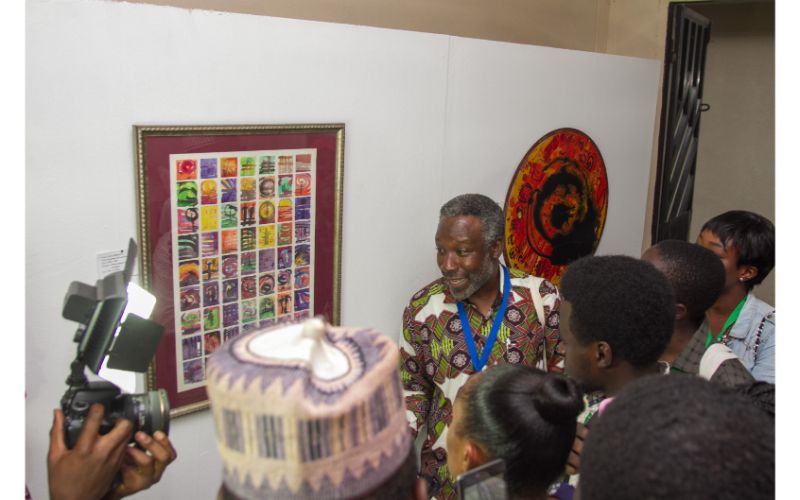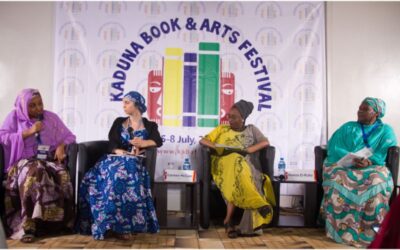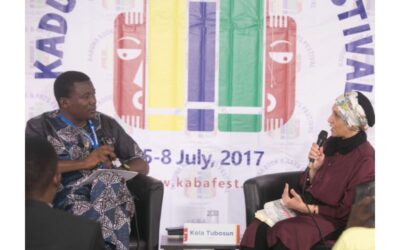Visions of Hope
At exactly 6:30 pm, on Wednesday, 5 July, the art exhibition titled ‘Visions of Hope’ was introduced and given a pride of place by the director of Book Buzz Foundation, Lola Shoneyin. She addressed enthusiasts and guests about the nature and manner the exhibition was to be carried out, as well as introduced the artists: Jerry Buhari, Mariam Shuaibu-Oyawoye, Williams CheChet, Kaltume B Gana, and Nura Garba mohammed.
The light in the corridor and the white walls studded with paintings gave art lovers a homely atmosphere as though hugging everyone into its embrace. As participants of the festival streamed through the corridor, Professor Jerry’s voice could be heard saying: ‘Artwork once done, assumes a life of its own. And can speak for itself.’ But he cautioned those who couldn’t buy it with their wallets to peacefully buy with their eyes and store it in the galleries of their minds.
Kultume’s ‘Never Again’ painting embodies the chaotic and complicated state of a country bedeviled by religious insurgency – Boko Haram. It strives to expose the several disguises fundamentalists have cushioned in the name of religion to perpetuate their deeds. Arabic calligraphic lines weaving through the rubbles depict an intricate pattern of misery, likewise the tears of suffering widows, orphans and the homeless. But the blue sky at the top of the canvas depicts the burning hope that birds will fly again. Mrs. Kultume B Gana’s approach as she stated is to document the essence of culture, and her works are always inspired or have Hausa/Fulani, Arabic and Kanuri cultural influences.
Inspired by childhood memories, William CheChet tries to strike a balance between old and new; pop art – Western and African. He explores African elements with an afro-futuristic appeal. It is this juxtaposing of concepts that Professor Jerry calls the digitalization of human lives on canvas. Favorite among them is ‘Ni Ma’, a canvas on board in which a pink canvas carries the face of an African male with emphasis on black-rimmed goggles dotted with gold, entwined looped earrings and necklaces reminiscent of either Fulanis in Northern Nigeria or the Masai in Kenya and Tanzania. The effort to fuse and to strike a balance penetrates most of his works on display.
The effort to not only document but to preserve and educate future generations is an outstanding feature in Nura Garba Mohammed’s paintings. ‘My City’ one of his oil on canvas paintings depicts a perceived shift in a society that gradually erodes ancient mud brick architecture with modern urban and suburban buildings. The communality shared by individuals in the old days is portrayed through the graphic cleanliness of the streets. The ‘duban-gari’ – sanitary inspectors, were said to enforce hygiene and healthy environment where necessary. Mohammed’s view of art as the expression of inner feelings as captured in his oil and canvas paintings ‘Miners’, and ‘African Beauty’, excited critics who reacted from different quarters.
When Professor Jerry Buhari said ‘flowers are hardly destroyed by individuals,’ he was referring to Mariam Shuaibu-Oyawoye’s works: ‘Healing’, ‘Growth and Change’, ‘Relationship’ , and ‘Encouragement’ which he asserts will be welcome in places experiencing crisis. The salient messages on her flowery canvases exude mediation and the need for not only a psychological awakening but a self-realization with the reality of self-forgiving as an extension of our humanity towards general healing. One of her flyers succinctly captures these: ‘Sometimes words fail us. Sometimes thoughts are too confused, obstacles too terrifying, courage too weak, energy too low, for us to express how we feel.’ Its drives down the point of inner workings of the mind through poetic representation of both words and colours, after all both are languages used in different arenas/disciplines.
From the mosaic ‘Symbols And Marks of a City’ portraying seasons, encounters, lives lived on the margins, religious and cultural pluralism among others, to ‘Guardians of the City’, ‘The Gbagyi Traveller,’ ‘Conference of Hawkers’, Jerry Buhari has shown his craftsmanship and versatility in the use of acrylic and enamel, watercolor, pencil, pastel and water colour on canvas among others. The work ‘Round Pot’ originally started in 1984 and inspired by a series of ancient paintings, Nok and Egyptian civilizations and the appropriation of different motives to fluidly capture the dynamism of culture, as we all as hybrid culture is arguably a masterpiece in its own right.
Professor Jerry’s works are conscious of the use of color which he says mirrors the way we live, and was quick to add that what we wear tells 70 percent of who we are. But of all virtues an artist should have is sincerity of purpose. Words are colors and the word is our canvas.
Written by Dominic Aboi



Comments are closed.